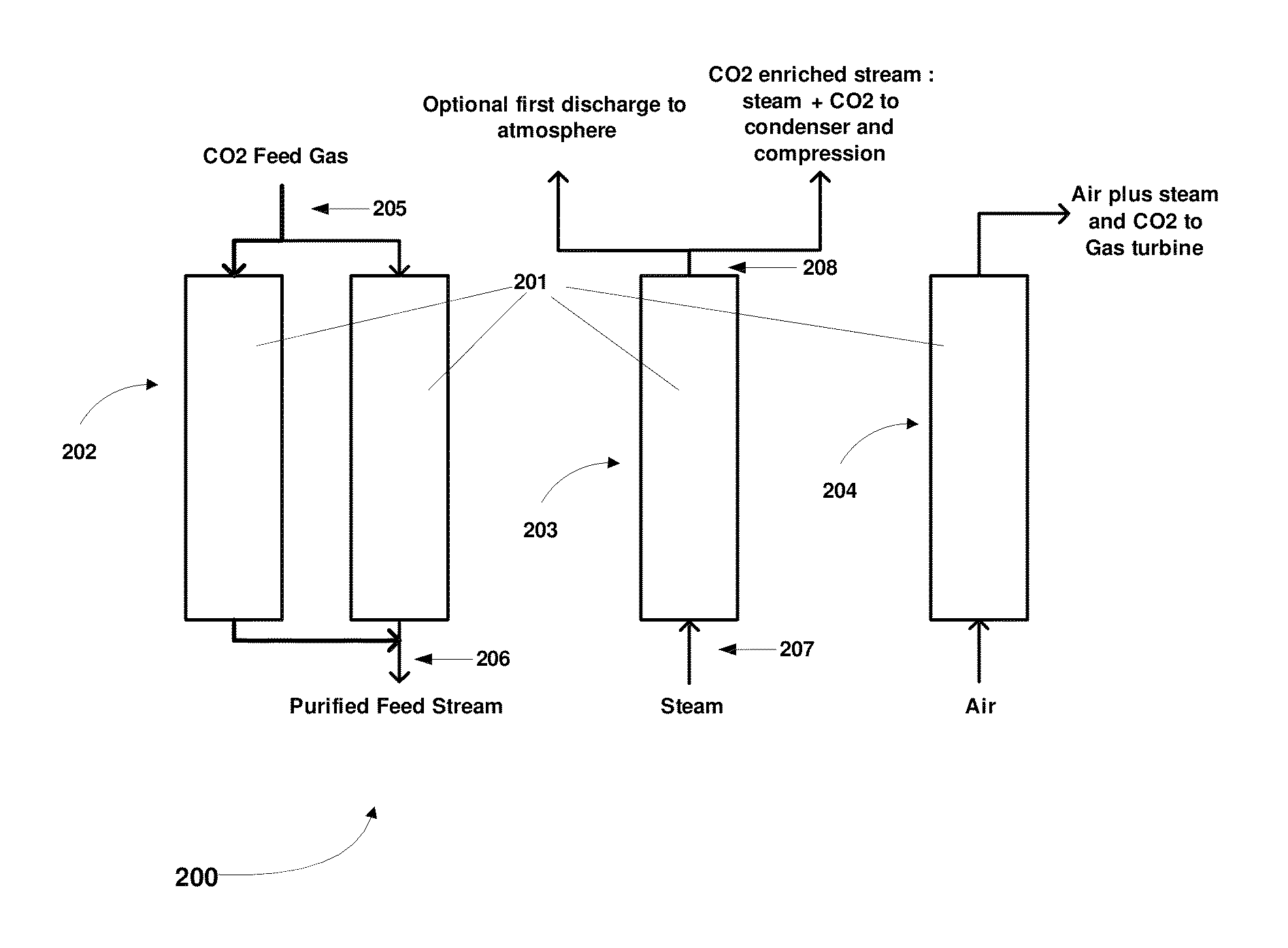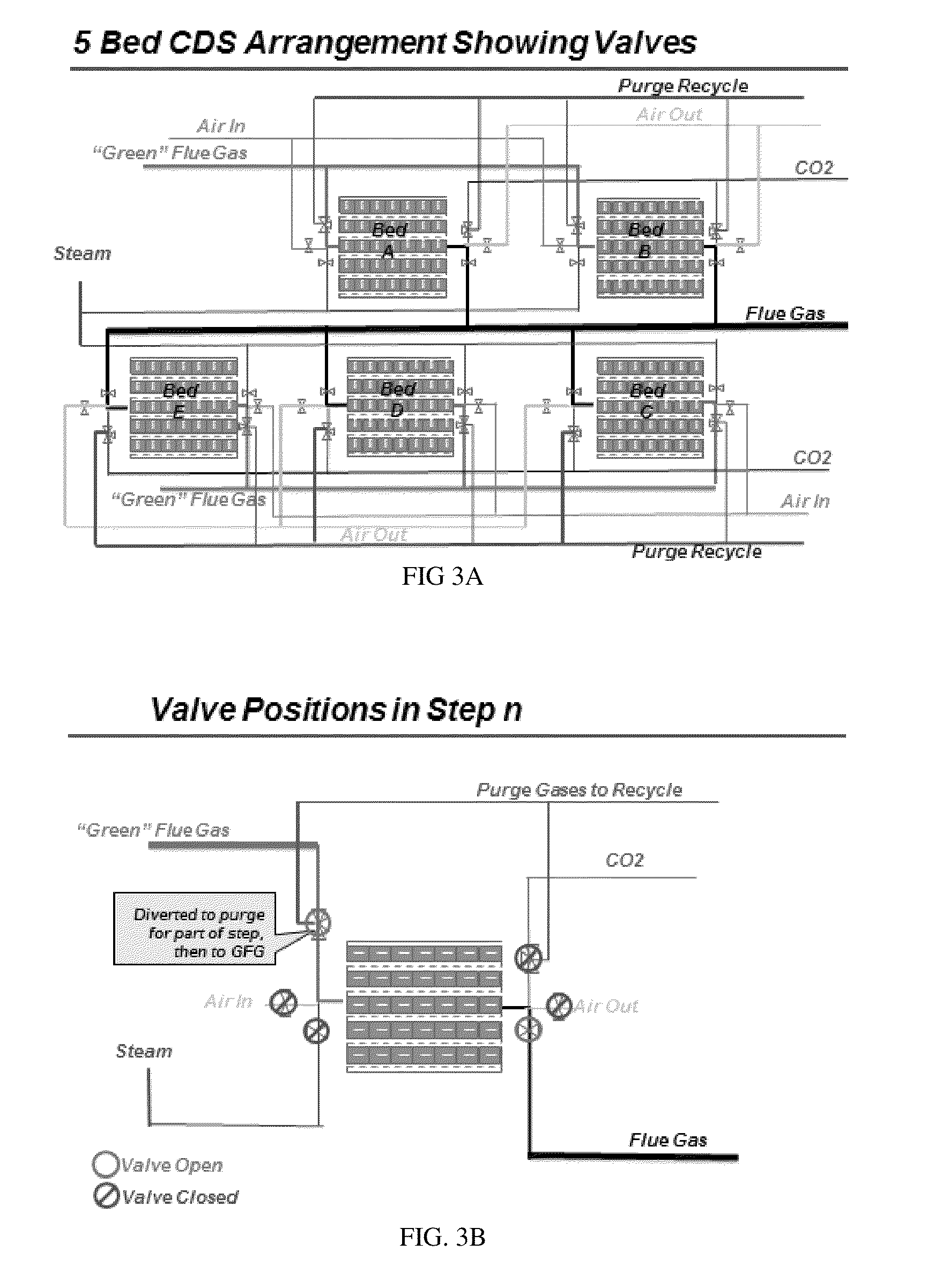Simulated moving bed system for CO2 separation, and method of same
a moving bed and cosub>2 technology, applied in the direction of separation process, dispersed particle separation, chemistry apparatus and processes, etc., can solve the problems of cosub>2 /sub>in the flue gas, all post-combustion cosub>2 /sub>capture technologies suffer from disadvantage, and large quantities of combustion gas produced in electric power generation
- Summary
- Abstract
- Description
- Claims
- Application Information
AI Technical Summary
Benefits of technology
Problems solved by technology
Method used
Image
Examples
example 1
Sorbent Preparation and Characterization
[0174]An alkalized alumina adsorbent was prepared from alumina powder (boehmite) and sodium carbonate. The boehmite and sodium carbonate were mixed in distilled water. The resulting solution was filtered and sediment dried. This sediment mixed with a nitric acid solution was extruded into pellets and fired.
[0175]As an example of a sample preparation, 210 g Boehmite V-700 (UOP), 132 g Na2CO3 and 900 ml H2O were mixed at 90° C. for 2 hours. The resulting solution was filtered, and the sediment was left to dry over night at room temperature. First, 380 g of the sediment material were put in the drying oven for 3.5 hours. Next, 309.4 g of the dried material were mixed with 163 ml of the HNO3 solution (0.75 ml HNO3 / 20 ml H2O). Pellets were extruded to ⅛″ diameter pellets, dried at room temperature and then calcined with heating from room temperature up to 100° C. at 0.2° C. / min. for 2 hours and then heating 100° C. up to 650° C. at 0.5° C. / min. for...
example 2
Sorbent Preparation and Characterization
[0177]An alkalized alumina adsorbent was prepared from alumina powder (boehmite) and sodium bicarbonate. The boehmite and sodium bicarbonate were mixed in distilled water. The resulting solution was allowed to settle, the solution decanted off and the precipitate dried. The precipitate was extruded into pellets with a sodium nitrate solution and fired. As an example of a sample preparation, 8903 g Boehmite Versal-700 (UOP), 5594 g NaHCO3, and 38.1 L H2O were mixed at room temperature for 18 hours. The solution was then allowed to settle and the excess solution was decanted off. The precipitate was dried at 150° F. Dried powder (8700 g) were mixed with 2% Methocel F4M (Dow) (174 g) and then combined with 8265 g of 3.75% NaNO3 solution. This material was extruded to ⅛″ pellets and air dried overnight and then fired at 400° C. for 4 hours.
[0178]This sorbent was characterized in a fixed bed where it was cycled under simulated natural gas flue gas ...
example 3
Sorbent Preparation and Characterization
[0179]An alkalized alumina adsorbent was prepared from alumina powder (gibbsite) and sodium bicarbonate. The boehmite and sodium bicarbonate were mixed in distilled water. The resulting solution was filtered and precipitate dried. This precipitate was mixed with a methocel FM and Volclay and was extruded with Boehmite solution (6.7% conc) into pellets and fired.
[0180]As an example of a sample preparation, 153.5 g Alcan WH31 (Alcan) which had been fired at 275° C. for 8 hr, 96.5 g NaHCO3 and 657.5 ml H2O were mixed at 90° C. for 1 hours. The resulting solution was filtered, and the filtrate was left to dry over night at room temperature and then dried at 100° C. for 1 hours. 150 g of the dried material were dry mixed with Volclay 353 CER (American Colloid Company) (16.7 g) and Methocel F4M (Dow) (3.34 g) and then mixed with 93.52 g of the Boehmite solution (6.7% conc). Pellets were extruded to 1 / 16″ diameter pellets, dried at room temperature a...
PUM
| Property | Measurement | Unit |
|---|---|---|
| pressure | aaaaa | aaaaa |
| pressure | aaaaa | aaaaa |
| pressure | aaaaa | aaaaa |
Abstract
Description
Claims
Application Information
 Login to View More
Login to View More - R&D
- Intellectual Property
- Life Sciences
- Materials
- Tech Scout
- Unparalleled Data Quality
- Higher Quality Content
- 60% Fewer Hallucinations
Browse by: Latest US Patents, China's latest patents, Technical Efficacy Thesaurus, Application Domain, Technology Topic, Popular Technical Reports.
© 2025 PatSnap. All rights reserved.Legal|Privacy policy|Modern Slavery Act Transparency Statement|Sitemap|About US| Contact US: help@patsnap.com



